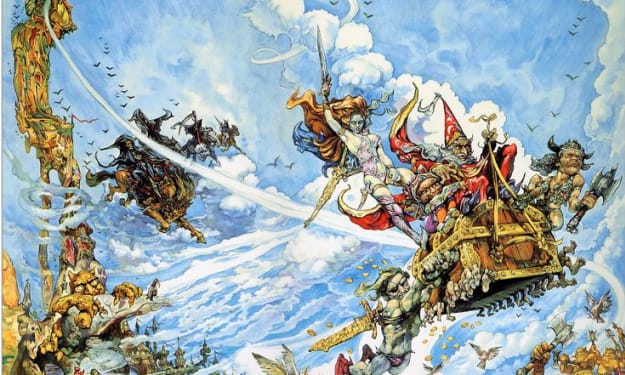Nolan Reviews: 'The Color of Magic' (1983) by Terry Pratchett
A Discworld Retrospective

I love Discworld. It is, without exaggeration, my favorite book series of all time. Terry Pratchett created a funny and thoughtful world all on one little disc atop four elephants atop a giant turtle. So, this year, I'm going to review each and every single book in this 41 novel epic. Let's get started.
First up in the series is The Color of Magic...which is not great, to be frank. The early books, as any fan will tell you, are really weak. The jokes are nowhere near as clever or densely packed with themes and humor as the later additions. The height of comedy here is a masturbation joke and a few paraphrased Woody Allen quotes. But lets judge this book on its own merits. No use in talking about what it could have been. Let's reckon with what it is.
The novel is the only Discworld book (outside of the children's books) that's divided into any sorts of chapters. The rest of the series goes for a more fast-paced, mini scenes that last for a couple of pages or even a couple of lines. It's more reminiscent of movie scenes and pacing than that of a traditional novel. Here, though, the book is structured as four long chapters, each one following a mini arc of misadventure for the main characters. It is also no accident that these mini arcs all are parody versions of classic fantasy tropes. The third story, for example, very closely resembles the Gor series aesthetically (Also, holy crap, John Norman is still writing books in that series?). However, everything is always brought to its extreme form. For example, The Discworld itself is not just the Flat Earth imagined in so much fantasy based around Medieval Europe. It's a Flat Earth on top of a bunch of elephants. And those elephants are on top of a giant sea turtle flying through the Cosmos (The Great A'Tuin is not-explicitly-a sea turtle, but that is the direction that most work derived from this series has gone in.). Why is the world so heightened and bizarre, especially compared to later books where bizarre things are treated as just a part of life? Because we are being introduced to this world from the viewpoint of an outsider.
The first book's protagonist is Rincewind the Wizard, who is used to this world. He is, however, tasked with being the tour-guide for our second lead, Twoflower. Twoflower is a foreigner from the Discworld equivalent of China. He is also kinda problematic in his portrayal as a stereotypical Asian tourist...but that's a whole other article (and one that will come with one of the later books). But, to Twoflower, all of these events are bizarre and alien. So, they are amped up in extremity. The absurdity of parody is here given a thematic reason. Then, throughout the book, we also have the idea teased that Rincewind himself will soon be in a land that's foreign to him. The novel literally ends with him leaving the Discworld behind and dropping into the blackness of space. It'll be fascinating to see how all of that plays out.
Tune in next week to see exactly how that plays out...





Comments
There are no comments for this story
Be the first to respond and start the conversation.